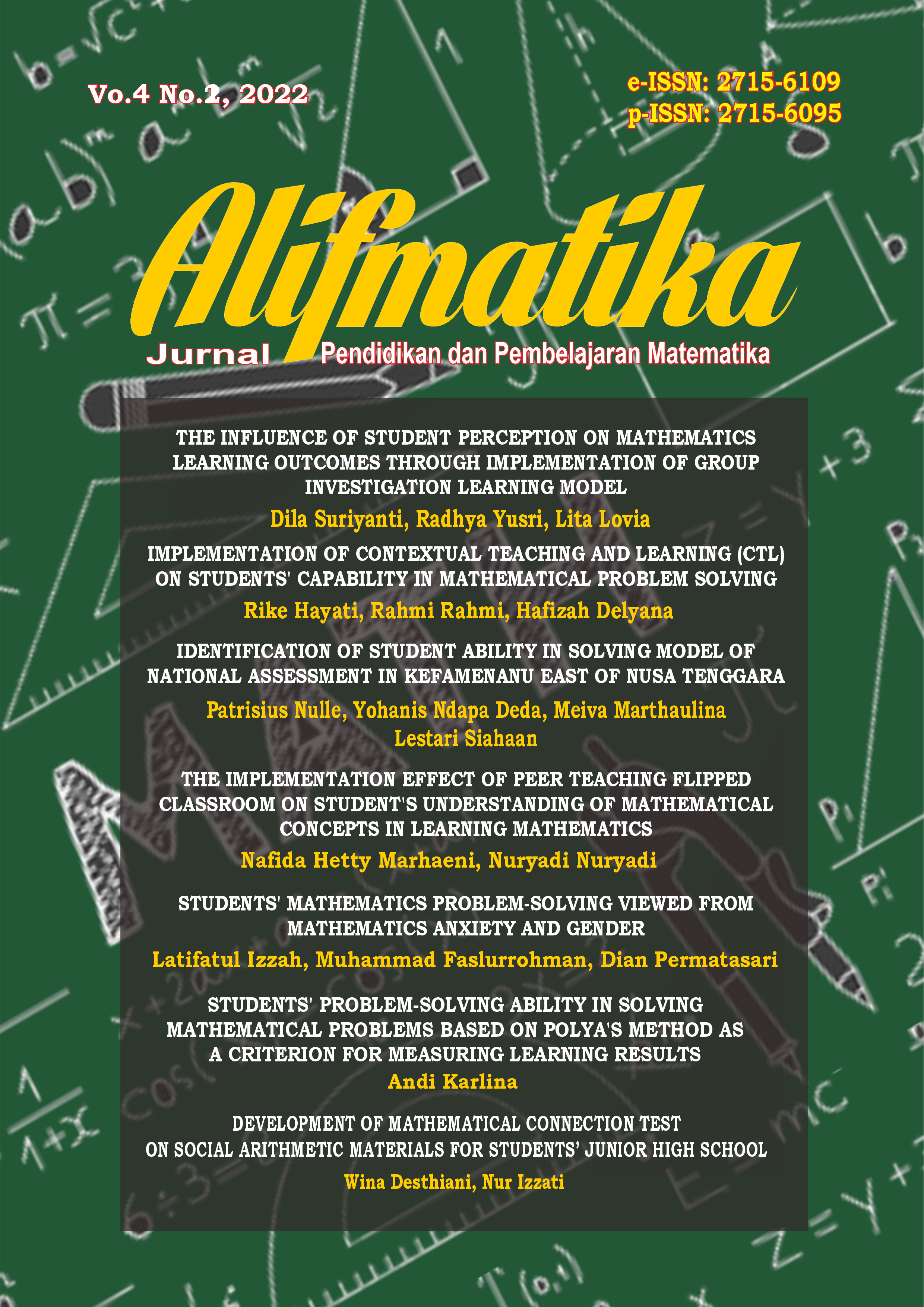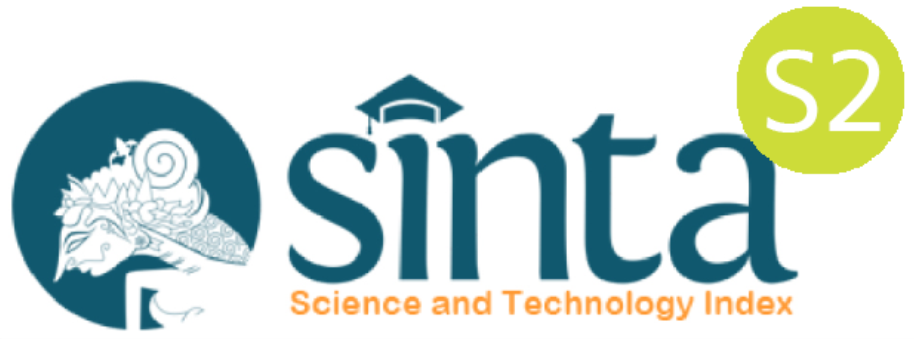IDENTIFICATION OF STUDENT ABILITY IN SOLVING MODEL OF NATIONAL ASSESSMENT IN KEFAMENANU EAST OF NUSA TENGGARA
DOI:
https://doi.org/10.35316/alifmatika.2022.v4i2.135-149Keywords:
National assessment, minimum competency assessment, numeracy ability, mathematicsAbstract
The purpose of the study was to determine the ability of students in solving the national assessment problem model. The study belonged to qualitative approach. The research was conducted at SMPK Putra St. Xavier Kefamenanu. The data conducted from test results of national assessment collection problems and selected-participants interviews. The collected data then identified based on the following stages: data reduction, data presentation, conclusion and verification. The results of data analysis showed that the level of students' ability in completing the national assessment model problems in the percentage is the low-level ability category of 30%, at the medium level by 60% and the high level by 10%. The findings of this study: students with high math ability master all components of MCA in terms of content, cognitive processes, and context; students with moderate math abilities are able to master reading literacy content but are weak in numeracy literacy; students with low math abilities are very weak in content, cognitive processes, and context. In terms of cognitive processes, students with moderate mathematical ability can find and interpret text content but fail to integrate and evaluate text content into mathematical concepts and procedures and the context of the questions that can be worked on are personal and scientific. In cognitive process, students with low mathematical abilities can find information but are unable to interpret it to evaluate the content of the text into a mathematical concept and procedure.
Downloads
References
Anggraini, Y. D. (2021). Penilaian Berbasis Opened Ended Question sebagai Alternatif Menghadapi AKM. Kompasiana.Com. https://www.kompasiana.com/yenni12457
Cahyana, A. (2020). Prospek akm dan survei karakter: Memperkuat basis praliterasi dan pranumerasi usia dini. Banpaudpnf Kemendiikbud, 1(1), 1–4. https://banpaudpnf.kemdikbud.go.id/upload/download-center/Prospek AKM dan survei karakter - memperkuat basis_1591186022.pdf
Cahyanovianty, A. D., & Wahidin, W. (2021). Analisis Kemampan Numerasi Peserta Didik Kelas VIII dalam Menyelesaikan Soal Asesmen Kompetensi Minimum (AKM). Jurnal Cendekia: Jurnal Pendidikan Matematika, 5(2), 1439–1448. https://doi.org/10.31004/cendekia.v5i2.651
Crain, W. C. (2005). Theories of development: concepts and applications. Universitas Indonesia. https://lontar.ui.ac.id/detail?id=20113260&lokasi=lokal
Creswell, J. W. (2013). Steps in conducting a scholarly mixed methods study. https://digitalcommons.unl.edu/dberspeakers/48/
Fauzi, I., & Arisetyawan, A. (2020). Analisis kesulitan belajar siswa pada materi geometri di Sekolah Dasar. Kreano, Jurnal Matematika Kreatif-Inovatif, 11(1), 27–35. https://doi.org/10.15294/kreano.v11i1.20726
Hendra, H. (2018). Peningkatan Hasil Belajar Matematika Siswa Kelas Xi Ipa Sman Negeri 1 Bangkinang Melalui Model Pembelajaran Kooperatif Tipe Stad. Jurnal Cendekia: Jurnal Pendidikan Matematika, 2(2), 29–41. https://doi.org/10.31004/cendekia.v2i2.47
Herman, H., Shara, A. M., Silalahi, T. F., Sherly, S., & Julyanthry, J. (2022). Teachers’ Attitude towards Minimum Competency Assessment at Sultan Agung Senior High School in Pematangsiantar, Indonesia. Journal of Curriculum and Teaching, 11(2), 1–14. https://doi.org/10.5430/jct.v11n2p1
Hidayah, A. R., & Ekawati, R. (2021). Proses Berpikir Siswa dalam Memecahkan Masalah Matematika Kontekstual Ditinjau dari Kemampuan Matematika dan Jenis Kelamin. Jurnal Ilmiah Pendidikan Matematika Volume, 10(1). https://doi.org/10.26740/mathedunesa.v10n1.p121-136
Indah, N., Mania, S., & Nursalam, N. (2016). Peningkatan kemampuan literasi matematika siswa melalui penerapan model pembelajaran problem based learning di kelas VII SMP Negeri 5 Pallangga Kabupaten Gowa. MaPan: Jurnal Matematika Dan Pembelajaran, 4(2), 200–210. https://doi.org/10.24252/mapan.2016v4n2a4
Melnick, S. D. (1974). Piaget and the pediatrician: guiding intellectual development. Clinical Pediatrics, 13(11), 913–918. https://journals.sagepub.com/doi/abs/10.1177/000992287401301101
Panggabean, R. F. S. B., & Tamba, K. P. (2020). Kesulitan belajar matematika: analisis pengetahuan awal [difficulty in learning mathematics: prior knowledge analysis]. JOHME: Journal of Holistic Mathematics Education, 4(1), 17–30. https://doi.org/10.19166/johme.v4i1.2091
Patta, R., Muin, A., & Mujahidah, M. (2021). Kemampuan literasi numerasi ditinjau dari gaya kognitif reflektif-impulsif. JIKAP PGSD: Jurnal Ilmiah Ilmu Kependidikan, 5(2), 212–217. https://doi.org/10.26858/jkp.v5i2.20130
Peng, P., Namkung, J., Barnes, M., & Sun, C. (2016). A meta-analysis of mathematics and working memory: Moderating effects of working memory domain, type of mathematics skill, and sample characteristics. Journal of Educational Psychology, 108(4), 455. https://doi.org/10.1037/edu0000079
Qayumi, S. (2001). Piaget and his role in problem based learning. Journal of Investigative Surgery, 14(2), 63–65. https://doi.org/10.1080/08941930152024165
Rokhim, D. A., Rahayu, B. N., Alfiah, L. N., Peni, R., Wahyudi, B., Wahyudi, A., Sutomo, S., & Widarti, H. R. (2021). Analisis Kesiapan Peserta Didik dan Guru pada Asesmen Nasional (Asesmen Kompetensi Minimum, Survey Karakter, dan Survey Lingkungan Belajar). JAMP: Jurnal Administrasi Dan Manajemen Pendidikan, 4(1), 61–71. https://doi.org/10.17977/um027v4i12021p61
Sanjaya, W. (2017). Perencanaan & desain sistem pembelajaran. Jakarta: Kencana Prenadamedia Group. https://repo.iainbatusangkar.ac.id/xmlui/handle/123456789/3697
Sari, L. N. (2016). Proses Berpikir Kreatif Siswa SMP dalam Memecahkan Masalah Matematika Nonrutin Ditinjau dari Kemampuan Matematika. Kreano, Jurnal Matematika Kreatif-Inovatif, 7(2), 163–170. https://doi.org/10.15294/kreano.v7i2.5919
Seel, N. M. (2014). Model-based learning and performance. In Handbook of research on educational communications and technology (pp. 465–484). Springer. https://doi.org/10.1007/978-1-4614-3185-5_37
Sundawan, M. D. (2016). Perbedaan model pembelajaran konstruktivisme dan model pembelajaran langsung. LOGIKA Jurnal Ilmiah Lemlit Unswagati Cirebon, 16(1). http://jurnal.ugj.ac.id/index.php/logika/article/view/14
Tohir, M., Anam, A. C., & Taufiq, I. (2021). Matematika untuk SMA/MA Kelas XII Kurikulum Merdeka Belajar. Pusat Perbukuan Badan Standar, Kurikulum, dan Asesmen Pendidikan Kementerian Pendidikan, Kebudayaan, Riset, dan Teknologi. https://buku.kemdikbud.go.id/katalog/buku-kurikulum-merdeka
Warli, W. (2014). Kreativitas siswa SMP yang bergaya kognitif reflektif atau impulsif dalam memecahkan masalah geometri. Jurnal Pendidikan Dan Pembelajaran (JPP), 20(2), 190–201. http://journal.um.ac.id/index.php/pendidikan-dan-pembelajaran/article/view/4396
Winata, A., Widiyanti, I. S. R., & Cacik, S. (2021). Analisis Kemampuan Numerasi dalam Pengembangan Soal Asesmen Kemampuan Minimal pada Siswa Kelas XI SMA untuk Menyelesaikan Permasalahan Science. Jurnal Educatio FKIP UNMA, 7(2), 498–508. https://doi.org/10.31949/educatio.v7i2.1090
Downloads
Published
How to Cite
Issue
Section
License
COPYRIGHT NOTICE
Author (s) who publish in Alifmatika: Jurnal Pendidikan dan Pembelajaran Matematika agree to the following terms:
- The Author (s) submitting a manuscript do so on the understanding that if accepted for publication, copyright of the article shall be assigned to Alifmatika: Jurnal Pendidikan dan Pembelajaran Matematika, Tarbiyah Faculty of Ibrahimy University as the publisher of the journal. Consecutively, author(s) still retain some rights to use and share their own published articles without written permission from Alifmatika: Jurnal Pendidikan dan Pembelajaran Matematika. This work is licensed under a Creative Commons Attribution-ShareAlike 4.0 International License.
- Copyright encompasses rights to publish and provide the manuscripts in all forms and media for the purpose of publication and dissemination, and the authority to enforce the rights in the manuscript, for example in the case of plagiarism or in copyright infringement.
- Alifmatika: Jurnal Pendidikan dan Pembelajaran Matematika and the Editors make every effort to ensure that no wrong or misleading data, opinions or statements be published in the journal. In any way, the contents of the articles and advertisements published in Alifmatika: Jurnal Pendidikan dan Pembelajaran Matematika are the sole responsibility of their respective authors and advertisers.
- The Copyright Transfer Form can be downloaded here [Copyright Transfer Form Alifmatika]. The copyright form should be signed originally and send to the Editorial Office in the form of original mail, scanned document to alifmatika[at]ibrahimy.ac.id or upload the scanned document in the comments column when sending the manuscript.























_by_Matematohir.jpg)






